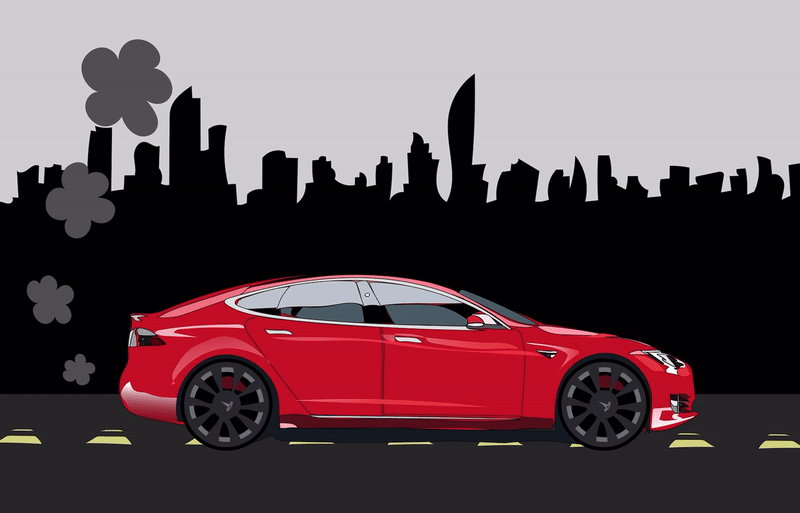Shocker, electric vehicles aren’t the solution
Teslas and other electric cars are gaining popularity as a more environmentally friendly alternative. The Sidekick staff designer Josh Campbell thinks electric cars are not the solution to modern vehicles’ environmental consequences. Graphic by Ashley Qian
January 27, 2022
Electric vehicles (EV) have recently become the seemingly fantastic alternative to internal combustion engine (ICE) vehicles; ICE vehicles are the traditional gas powered cars we use today. EVs, with no CO2 tailpipe emissions, must be our saving grace against pollution, right?
Truthfully, the automotive industry just is not to the point where EVs are the defined replacement for ICE. While Tesla has helped greatly to bring the EV market to the forefront, there are underlying issues that need to be addressed in terms of environmental concerns.
First, power plant emissions. So yes, your new electric vehicle is clean, running on state of the art lithium ion batteries. But where do you acquire all this power to charge those batteries?
The likely answer is coal or natural gas. The first step to creating a true eco-friendly automotive process is not only having electric vehicles, but having eco-friendly power plants as well. Having electricity provided by alternative energy sources such as wind, solar and others would push the EV to be greatly cleaner than that of emissions from ICE vehicles.
Even with EV’s charging power originating from fossil fuel plants, according to research done by the U.S. Environmental Protection Agency (EPA), EVs still are cleaner in greenhouse gasses than ICE. This goes as well for manufacturing these vehicles. While factories burn away the traditional fossil fuels, the zero tailpipe emissions of EVs still outweighs that of ICE vehicles.
But the true problem lies in the batteries themselves. An EV contains thousands of individual lithium ion cells. These batteries are extremely difficult to recycle compared to any other traditional batteries due to their complex chemical composition. Less than five percent of the battery’s materials are recyclable. This process consumes a large portion of energy which often leads to more pollution. If electric cars are to dominate the automotive market, they first need to become the true environmentally friendly alternative.
Because currently, EVs are not the solution.
Fortunately, EVs aren’t the only option. German automaker Porsche dipped its toes into the new market with the popular Porsche Taycan. A stunning vehicle of performance and style, unlike Tesla, has recently begun research into an alternative fuel.
Porsche’s synthetic fuel gathers electricity powered by wind, lowering emissions in the production process, an issue I mentioned before with the current mass production cycle.
This synthetic fuel, or eFuel, is created through the process of electrolysis, then combined with CO2 to form methanol, which can then be converted into fuel.
As a car enthusiast, I greatly hope Porsche’s eFuel can become widely accessible. This would allow for gas guzzling classic cars to stay on the road, a huge win for many in the community. Porsche’s eFuel would be compatible not only with any ICE, but current infrastructure could also be easily converted to supply the fuel.
Unfortunately, the current outlook for prices of eFuel would be close to $7.60 per gallon, a little bit out of my price range, and most drivers.
When buying a new car, whether ICE or EV, be wary of how efficient the car is and consider hybrids and low emission vehicles for your next purchase. Avoid cars with lower mpg averages, for the environment and your wallets sake. Large, heavy vehicles or performance oriented cars are often the culprit behind the gas guzzling.
In EVs, be looking for the battery range, the distance it can travel on a full charge. Tesla vehicles do have some of the longest ranges available currently, though with many other manufacturers catching up in the EV market; more options will be available in the coming years.
EVs need work, yet other options are available for those not yet willing to convert to electric. It is an exciting time in the automotive world. Change is due, and with it has come wild last hurrahs of ICEs like Dodge’s supercharged V8 Durango, an SUV which has no need for 700 horsepower. Or EVs which bring performance to a level which ICEs never could, such as Audi’s E-tron GT or Tesla’s very own Model S Plaid, currently one of the fastest production cars.
Here’s to the future of motorsports, performance, style and driving to work more efficiently.











